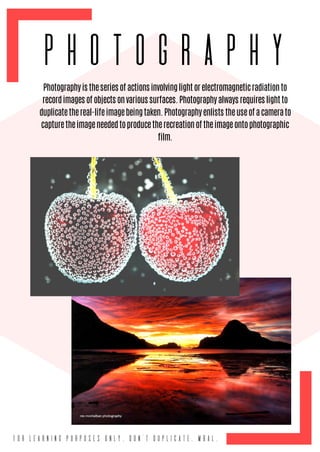
Mapeh 10 - Photography
- 1. Photographyis theseries of actions involvinglightorelectromagneticradiationto recordimages of objects onvarious surfaces. Photographyalways requires lightto duplicatethereal-lifeimagebeingtaken. Photographyenlists theuseofacamerato capturetheimageneededtoproducetherecreationof theimageontophotographic film.
- 2. principles of Balanceis arrangingthe elements inapieceso thatthereis equalityfrom onesidetotheother. A symmetricalimagehas perfect balance. Balance canalsobeachievedby asymmetryorradial arrangement. Beloware anexampleof bothpoor andgoodbalance. 1. Balance balance. Balancecanalsobeachievedbyasymmetryorradialarrangement. 2. Harmony Thedictionarydefinitionof harmonyis “aconsistent, orderly,orpleasing arrangementof parts; congruity”. This happens in artbyusingsimilar elements throughoutapiecethatbring ittogetherina“pleasing” way. Harmonycanbe consideredsimplicity. I chosethis imageto representagoodharmony. elements throughoutapiecethatbringittogetherina“pleasing” way. Harmonycan beconsideredsimplicity. This is oneof themost difficultprinciples tograsp.
- 3. 3. Rhythm/Pattern Patternorrhythmis simplyrepeatingan element insuchamanner. This willcausethe viewer’s eyetomovearoundtoeach element. 4. Unity Unityis takingtheparts of apieceofartandunifyingthemintosomethingbetteras awhole. Compositionis agreatwaytodothis. This imagecouldbeseparatedinto eachpartas its ownpiece,buttogethertheybecomeaunifiedcomposition. 5. Contrast Contrastis easy. Itis similartoadding contrast toanimageoverall,butthis is donebyusingtheelements. Youcan createcontrastinanimagebyusing complementarycolors ordifferences in light anddark.
- 4. 6. Proportion Proportionis usingthesizeof an objecttogiveitmoreorless importance. Findinganimagethat uses this purposefullywas difficult. 7. Variety Varietyis exactlywhatitsounds like, havingvarietyinyourelements. The imageontherighthas varietyin eachof theshells. Bydifferingthe kinds of shells,I’vecreatedvariety thatstillmaintains unityinthatthey areallshells. varietyis createdthatstillmaintains unityinthattheyareallshells. 8. Movement Movementis oneof thesimpler principles tolearn; I actuallyusedit alotwhendiscussingtheElements of Art. Thegoalof creatingmovement is toleadtheviewer’s eyeallaround thephotoandlandonthefocal point. Theimagebelowdoes agreat jobof thatusinglineandtone.
- 5. origin of Likemanymoderntechnologies digitalphotographycantraceits beginnings back to“SpaceRace” whentheUnitedStates andtheSovietUnionwereincompetition forsupremacyinouterspaceandwereracingtobethefirstcountytoputamanon themoon. This timeperiodfrom1957-1975sawanunparalleledadvancementintechnology, includingthebeginningdevelopmentof digitalcameras anddigitalphotography. 1961 EugeneF. Lallyof theJetPropulsion Laboratorybeganworkingonawaytouseamosaicphotosensor to capturedigital images. 1969 Was particularlyimportantin thehistoryof digital photographybecauseGeorgeSmith andWillard Boyleof Bell Laboratories developedtheCCD (charge-coupled-device) anddemonstratedit on October 17, 1969. This CCDimagesensor is theheartthedigital cameradevelopmentbecauseit is thesolid-state devicethatconverts light intoelectricsignals. This major breakthrough in 1969providedthekeypiece of technologytobegin thedigital photographyrevolution. CCDimagesensors arestill widelyused today. Whiletoday’s CCDimagesensors oftenhave12-14megapixels thefirstonein 1969was only100x 100pixels. From1969to1978CCD technologycontinuedtobedevelopedandin 1978Bell Laboratories successfullycreatedanimagesensorwith 500x500pixel array. 1970 GeorgeSmith andWillardBoyleof Bell Laboratories builtthefirst solid-statevideocamera. 1972 Texas Instrumentemployee,Willis Adcockpatentedafilm-less camerahowever thetechnologywas still not availabletomakeitaviableconcept. 1973 FairchildImagingproducedthefirstcommercial CCD imager. This 10,000pixel sensor (100x100pixels) wouldbecomethefoundation fortherapidlydevelopingworldof digital imaging.
- 6. 1985 Fuji makes theES-1aSVC (still videocamera) witha640x480pixel CCDimager. This camerawas an SLRwith a50-150mmmanualzoom. 1975 EastmanKodakengineer StevenSasson patentedaprototypedigital camerausingtherecentlyinvented FairchildCCDimagesensor andalens fromaKodakmoviecamera. This camerawas aboutthesizeof a largetoaster andweighedalmostninepounds. Theblackandwhitedigital imagewas storedona cassettetapeandin ordertoviewtheimages theKodakengineers hadtodevelopaspecial screen. It was abletocapturea.01megapixel image(10,000pixels) andtook23seconds torecordanimagetothe tape. 1975 Anothermilestoneinthehistoryof digital photographywas when BryceBayerinventedtheBayerColor Filter Arraythat enabledasingleCCDorCMOSimagesensortocapturecolor images. Without this filter capturingcolorimages wouldrequirethreeseparatesensors attachedtoacolorbeamsplitterwhich wouldbeboth largeandexpensive. BayerColor FilterArrays areusedinalmosteverydigital camera madetoday. 1978 Leicademonstrates thefirstSLRwith fullyoperationalautofocus at thePhotokinaphotographyshow. 1981 Thefirsttrueworkingdigital camerawas built bytheUniversityof CalgaryCanadaASI ScienceTeam. Their All-Skycamerawas designedtophotograph auroras andusedoneof the100x100pixel Fairchild CCD imagesensors. 1986 Canon beganmanufacturinganddistributingdigital cameras withthereleaseof theRC-701aSVC(still videocamera)thathadfourinterchangeablelenses andsoldforabout$3,000. 1981 SonyElectronics introducedtheMavica(MagneticVideoCamera), avideocamerawhich recordedimages on afloppydisk. This earlyelectroniccamerahadaresolution of 720,000pixels (.72megapixels) andwas abletostoreupto50images on asingle2.0” videofloppydisk. Describedas havingbeginning“anewera in photography” theSonyMavicawas asinglelens reflexcamerawiththreeinterchangeablelenses capableof capturingimages tothefloppydiskanddisplayingthembackon aTV. Whilean important milestonein thehistoryof digital photographythis was essentiallyavideocamerathat tookstill images andnotatruedigital camera. Nevertheless thedevelopmentof this camerais averyimportantevent alongthedigital photographytimeline.
- 7. 1986 Kodakintroduceda1.4megapixel sensormakingit thefirstmegapixelsensorsmallenough tofit in a handheldcamera. This sensorwas usedintheVidekMegaplus cameradesignedforscientificand industrialuse. Thesecameras soldbetween $10,000and$40,000andwereessentiallythefirstcamera with enoughresolution toproducea5x7photoqualityprint. 1988 Fuji developedtheDS-1Pwhichis consideredtobethefirstfullydigital consumercameratobesold. This camerarecordedimages digitallyona16MBinternalmemorycardandhad16mm F/5.6lens with shutterspeeds from1/60/to1/200of asecond.Nikon_D90Nikon_D90 1988 Sonyintroduces theMVC-C1thefirst consumermodelof their MAVICAlineof electronicstill videocameras. This MAVICAwas describedas “astill videocamerathat records pictures magneticallywithout theuseof film.” Likeother MAVICAmodels this was not atruedigital camerabut was averyimportantstepin the evolutionof digital cameras. 1988 Digital Darkroomwas releasedbecomingthefirstimageeditingsoftwarefortheMacintosh computer. 1988 sawanotherkeyeventinthehistoryof digital photographywhenthefirst JPEGandMPEGstandards wereset. Thesestandards setinplaceauniversal format whichallowedimages (JPEG)andvideo(MPEG) tobestoredin acompressedformat. 1990 Kodakdevelops thePhotoCDsystemandproposes thefirst“ worldwidestandardfordefiningcolor inthe digital environmentof computers andcomputerperipherals.” 1990 AdobereleasePhotoshop1.0makingit theseconddigital editingprogramavailablefor Macintosh computers andan importantmilestoneinthedigital photographytimeline. 1990 Logitech introduces theDycamModel IandFotomandigital cameras. Itwas atruedigital cameracapable of capturing320x320pixel blackandwhitephotos. Thecamerahad1MBof internal memorythat could storeupto32photos. Ithada8mmfixed-focus lens with ashutterspeedrangeof 1/30to1/1000second. Thecameracamewithacabletodownloadthesephotos toacomputer andsoldfor $995. 1991Anothermilestoneinthedigital photographytimelinewas whenKodakreleasedthefirst professional digital camerasystemmarketedtowards journalists. ItusedaNikon F-3camerafilmbodyadaptedwith a 1.3megapixel KodakCCD imagesensor. It soldfor $13,000.
- 8. 1. Lookat yoursubject intheeye. Direct eyecontactcanbeas engagingina pictureas it is inreallife. Whentakinga pictureof someone,holdthecameraat theperson’s eyeleveltounleashthe powerof thosemagneticgazes and mesmerizingsmiles. Forchildren,that means stoopingtotheirlevel. Andyour subject neednotalways stareat the camera. Allbyitself thateyelevelangle willcreateapersonalandinvitingfeeling thatpulls youintothepicture. 2. Useaplainbackground. Aplainbackgroundshows off the subjectyouarephotographing. Whenyoulookthroughthe cameraviewfinder,forceyourself tostudytheareasurrounding yoursubject. Makesurenopoles growfromtheheadof your favoritenieceandthatnocars seemtodanglefromherears. tips on taking always stareatthecamera. Allbyitself thateyelevelanglewillcreateapersonaland invitingfeelingthatpulls youintothepicture.
- 9. Bright suncancreateunattractivedeepfacialshadows. Eliminatetheshadows byusing yourflashtolightentheface. Whentakingpeoplepictures onsunnydays,turnyourflash on. Youmayhaveachoiceof fill-flashmodeorfull-flashmode. If thepersonis withinfive feet,usethefill-flashmode; beyondfivefeet,thefull-powermodemayberequired. Witha digitalcamera,usethepicturedisplaypaneltoreviewtheresults. 3. Useflashoutdoors. 4. Moveinclose. If yoursubjectis smallerthanacar, takeastepor twocloserbeforetakingthepictureandzoominon yoursubject. Yourgoalis tofillthepictureareawith thesubject youarephotographing. Upcloseyoucan revealtellingdetails,likeasprinkleof freckles oran archedeyebrow. Butdon’tgettoocloseoryourpictures willbeblurry. Theclosestfocusingdistanceformostcameras is aboutthreefeet,oraboutonestepawayfromyour camera. If yougetcloserthantheclosestfocusing distanceof yourcamerayourpictures willbeblurry.
- 10. 5. Moveitfromthemiddle. Center-stageis agreatplaceforaperformertobe. However,themiddleof yourpictureis notthebest placeforyoursubject. Bringyourpicturetolifeby simplymovingyoursubjectawayfromthemiddleof yourpicture. Startbyplayingtick-tack-toewith subjectposition. Imagineatick-tack-toegridin yourviewfinder. Nowplaceyourimportantsubjectat oneof theintersections of lines. You’ll needtolockthefocus if youhaveanauto- focus camerabecausemostof themfocus on whateveris inthecenterof theviewfinder. 6. Lockthefocus. If yoursubjectis notinthecenterofthe picture,youneedtolockthefocus tocreatea sharppicture. Mostauto-focus cameras focus onwhateveris inthecenterofthe picture. Buttoimprovepictures,youwilloften want tomovethesubjectawayfromthe centerof thepicture. If youdon’twanta blurredpicture,you’ll needtofirstlockthe focus withthesubjectinthemiddleandthen recomposethepicturesothesubjectis away fromthemiddle.
- 11. 7. Knowyourflash’s range. Thenumberoneflashmistakeis takingpictures beyondtheflash’s range. Whyis this amistake? Becausepictures takenbeyondthemaximumflash rangewillbetoodark. Formanycameras, the maximumflashrangeis less thanfifteenfeet— aboutfivesteps away. Whatis yourcamera’s flashrange?Lookitupin yourcameramanual. Can’tfindit?Thendon’ttake achance. Positionyourself sosubjects areno fartherthantenfeetaway. Filmusers canextend theflashrangebyusingKodakMaxversatilityor versatilityplus film. 8. Watchthelight. Nexttothesubject,themostimportantpartof everypictureis thelight. Itaffects theappearanceof everythingyou photograph. Onagreat-grandmother,brightsunlightfromthe sidecanenhancewrinkles. Butthesoftlightof acloudydaycan subduethosesamewrinkles. Don’tlikethelightonyoursubject?Thenmoveyourself oryour subject. For landscapes,trytotakepictures earlyorlatein thedaywhenthelightis orangishandrakes across theland.
- 12. 9. Takesomeverticalpictures. Allsorts of things lookbetterina verticalpicture. Fromalighthouse nearacliff totheEiffelTowertoyour four-year-oldniecejumpingina puddle. Sonexttimeout,makea conscious efforttoturnyourcamera sideways andtakesomevertical pictures. 10. Beapicturedirector. Takecontrolof yourpicture-takingandwatch yourpictures dramaticallyimprove. Becomea picturedirector,notjustapassivepicture- taker. Apicturedirectortakes charge. Apicture directorpicks thelocation. Apicturedirector adds props. Apicturedirectorarranges people: Mostpictures won’tbethatinvolved,butyou get theidea: Takechargeof yourpictures and winyourownbestpictureawards. http://www.kodakmoments.com/projects -center/top-10-tips-for-great-pictures/
